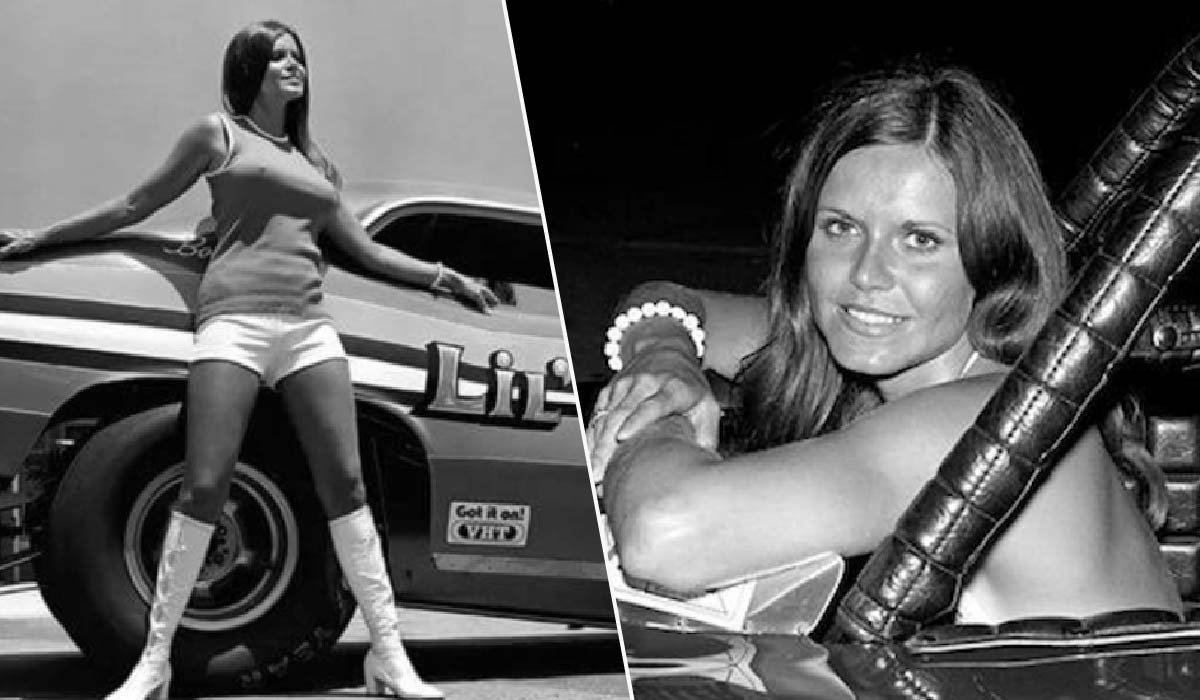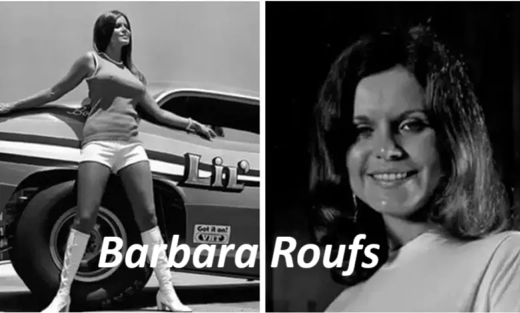Barbara Roufs In the roaring world of American motorsports, where engines thunder and adrenaline runs high, there exists a pantheon of legends remembered for their speed, courage, and charisma. Yet, beyond the drivers and mechanics, another group of trailblazers helped shape the culture and excitement of racing. Among them was Barbara Roufs — a name that once lit up the drag racing scene of the 1960s and 1970s. Though her time in the spotlight was relatively brief, her impact was undeniable. Barbara Roufs became an icon of style, spirit, and beauty during drag racing’s most transformative years. Today, decades after her passing, she remains a symbol of a vibrant era and a fascinating figure worth rediscovering.
A Star is Born: Early Life and Roots
Barbara Roufs was born in California, a state that was fast becoming the beating heart of American motorsports in the mid-20th century. While details about her childhood remain scarce, what is known is that Barbara grew up during a period of immense cultural change. The post-war boom had ushered in a new era of prosperity, and car culture was exploding. Teenagers were customizing hot rods, local drag strips were popping up across the country, and racing was evolving from a grassroots passion into a professional sport.
Barbara’s natural charm, charisma, and striking beauty quickly set her apart. But it wasn’t just her appearance that made her special — she had an energy and presence that made people take notice. These qualities would eventually lead her to the center stage of a world dominated by noise, speed, and male competition: the drag strip.
Enter the Drag Racing Scene

By the late 1960s, drag racing had grown far beyond its rebellious, underground beginnings. The National Hot Rod Association (NHRA) was turning it into a mainstream motorsport, with sponsors, media coverage, and packed grandstands. But drag racing was still very much a male-centric world — from the drivers to the pit crews and promoters. Barbara Roufs helped change that dynamic.
Barbara entered the racing scene not as a driver, but as a trophy girl and promotional model — roles that were crucial to the sport’s growing entertainment value. Trophy girls were the glamorous faces of racing events, presenting awards, greeting fans, and embodying the celebratory spirit of the sport. Barbara’s stunning presence, with her tall figure, bright smile, and 1970s fashion sense, made her a fan favorite almost instantly.
She became a regular fixture at drag racing events throughout California and beyond. Her most notable appearances were with the “Professional Dragster Association” and the “NHRA Winternationals,” where she represented the epitome of California cool — bold, vibrant, and effortlessly stylish.
The Style Icon of Drag Racing’s Golden Age
Barbara Roufs wasn’t just a trophy girl — she was a fashion icon in her own right. At a time when drag racing was evolving into a full-fledged spectator sport, Barbara helped redefine what it looked like. Gone were the conservative uniforms of earlier decades. Barbara embraced the changing fashion trends of the late 1960s and 1970s: miniskirts, go-go boots, bell-bottoms, and bold prints.
Her appearance wasn’t simply about aesthetics — it was a symbol of cultural transformation. The women’s liberation movement was reshaping society, and Barbara represented a new kind of confidence and independence. She wasn’t there to be a passive decoration; she was part of the show, a personality in her own right.
Fans adored her. Photographers loved capturing her dynamic presence on the drag strip. Her images appeared in motorsport magazines, posters, and event programs. Barbara’s blend of glamour and grit helped make drag racing more appealing to a broader audience, including women who might never have considered attending a race before.
The Role of Trophy Girls in Motorsport History
To understand Barbara Roufs’ legacy, it’s important to appreciate the significance of trophy girls during her time. In many ways, they were ambassadors of the sport. They interacted with fans, promoted sponsors, and brought a sense of celebration to the events. They also helped humanize a sport that could otherwise seem intimidating or inaccessible to outsiders.
Barbara excelled in this role. Her outgoing personality, radiant smile, and genuine love for the racing community made her more than just a figure on the podium. She was part of the family — a beloved member of a tight-knit subculture that valued passion and personality as much as horsepower and speed.
A Cultural Icon Beyond the Track
Barbara Roufs’ influence extended beyond the drag strip. She became a symbol of 1970s Americana — an era defined by bold self-expression, freedom, and the pursuit of excitement. In many ways, she embodied the spirit of the time: rebellious yet elegant, glamorous yet grounded.
She appeared in promotional materials, advertisements, and racing magazines. Fans would often line up for autographs or photos, and she became a recognizable face at events across the West Coast. Her popularity even helped boost the visibility of the sport itself, drawing new audiences and contributing to drag racing’s rapid growth.
Barbara’s presence also challenged traditional gender roles. At a time when motorsport was overwhelmingly male-dominated, she demonstrated that women could play influential roles in shaping its culture and identity. She paved the way for future generations of women — not only as trophy girls or models but as journalists, promoters, and even drivers.
The Challenges Behind the Spotlight
Despite the glitz and glamour, the world Barbara inhabited was not without its challenges. The life of a promotional model in motorsports could be demanding and often underappreciated. Long hours, extensive travel, and the pressure to maintain a public image were constant realities. Moreover, the recognition they received often paled in comparison to the drivers and teams they supported.
Barbara’s story, like that of many women in entertainment and sports during that era, was marked by the tension between visibility and vulnerability. While she was admired publicly, her private life remained largely unknown. What is certain is that the demands of the spotlight — combined with the intense pressures of a changing cultural landscape — were not easy to navigate.
Legacy and Tragic End
Barbara Roufs’ life came to a tragic end when she passed away in 1991, leaving behind a legacy that continues to resonate with motorsport enthusiasts to this day. The details of her later years remain shrouded in mystery, and her untimely death cast a shadow over what had been a bright and influential career.
Yet, even decades later, Barbara’s impact is still felt. Photographs of her at the height of her fame continue to circulate among racing fans and historians, serving as vivid reminders of drag racing’s golden age. For many, she represents the heart and soul of a bygone era — a time when racing was raw, exciting, and full of personality.
Why Barbara Roufs Still Matters Today
In the age of social media and global sports entertainment, it’s easy to forget how important figures like Barbara Roufs were in shaping the culture of motorsports. Today, trophy girls have evolved into brand ambassadors, influencers, and spokespeople. Women are now racing at the highest levels, reporting from pit lanes, and leading motorsport organizations. All of this progress is built on the foundations laid by pioneers like Barbara.
Her story is a reminder that impact isn’t always measured by trophies or records. Sometimes, it’s about presence — about how someone makes a sport more welcoming, more vibrant, and more memorable. Barbara did exactly that. She brought joy, glamour, and humanity to a sport that was still finding its identity. She helped turn drag racing into more than just a competition; she helped make it a spectacle.
A Symbol of an Era — And an Inspiration for the Future
The story of Barbara Roufs is also the story of a transformative time in American culture. The 1960s and 1970s were decades of change — politically, socially, and culturally. Drag racing mirrored that evolution, moving from dusty backroads to professional circuits, from niche pastime to national phenomenon. And Barbara was there, at the heart of it all, embodying the optimism, rebellion, and creativity of the era.
Today, when fans look back at photos of Barbara — standing tall on the drag strip with the wind in her hair and a smile that could light up the stands — they see more than just a trophy girl. They see a symbol of what made motorsports magical: passion, community, and the thrill of living life at full speed.
Remembering Barbara Roufs: The Woman Behind the Icon
It’s easy to reduce Barbara Roufs to a symbol — of beauty, of an era, of drag racing itself. But behind the iconic images was a real person. Friends and colleagues remembered her as warm, friendly, and full of life. She loved the racing community and was genuinely invested in the people around her. Her ability to connect with fans and drivers alike wasn’t just part of her job — it was part of who she was.
This humanity is what makes her legacy endure. Barbara Roufs wasn’t just a glamorous figurehead; she was a beloved member of the racing family. Her story resonates because it’s about more than fame — it’s about passion, dedication, and the power of presence.
The Enduring Allure of Barbara Roufs
As motorsports continues to evolve, the legends of its past remain a vital part of its identity. Barbara Roufs is one such legend — a name that may not appear in record books but lives on in the memories of those who witnessed her charm and charisma firsthand. She represents a bridge between the grassroots spirit of drag racing’s early days and the global spectacle it has become today.
Her legacy also serves as an inspiration for anyone who wants to make a difference in their field, regardless of the role they play. Barbara proved that you don’t have to be behind the wheel to leave a lasting mark on the sport you love. Sometimes, being the heart and soul of the event is just as important as crossing the finish line first.
Conclusion: Barbara Roufs and the Timeless Spirit of Drag Racing
Barbara Roufs may have stepped out of the spotlight decades ago, but her influence continues to reverberate through the world of motorsports. She was more than a trophy girl — she was an icon of style, a pioneer of representation, and a vital part of drag racing’s story during its most exciting era. Her beauty captured attention, but her spirit captured hearts.
Today, as we look back on the golden age of drag racing, Barbara’s story reminds us that the sport’s magic has always been about more than speed and power. It’s about the people — the personalities who make the events unforgettable and who bring humanity to the roar of the engines. Barbara Roufs was one of those people. She was the face of a generation, the queen of the drag strip, and a timeless symbol of passion and possibility.
Though her life was cut tragically short, Barbara’s legacy endures — not just in photographs and memories but in the vibrant, inclusive spirit of motorsports today. She will forever be remembered as the woman who brought grace to the grit, glamour to the gearheads, and heart to the high-octane world of drag racing.

















































































